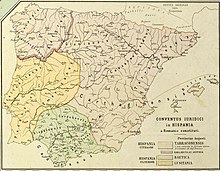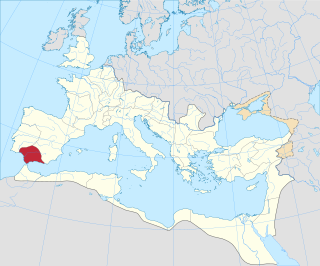
In Ancient Rome territorial organization, a conventus iuridicus was the capital city of a subdivision of some provinces (Dalmatia, Hispania, Asia) with functions of seat of a district court of justice and maybe others. [1]

In Ancient Rome territorial organization, a conventus iuridicus was the capital city of a subdivision of some provinces (Dalmatia, Hispania, Asia) with functions of seat of a district court of justice and maybe others. [1]

Lusitania was an ancient Iberian Roman province encompassing most of modern-day Portugal and a large portion of western Spain. Romans named the region after the Lusitanians, an Indo-European tribe inhabiting the lands.
Neoliotomus is a genus of North American mammal from the Paleocene. It existed in the age immediately following the extinction of the last dinosaurs and was a member of the extinct order Multituberculata. It lies within the suborder Cimolodonta and the superfamily Ptilodontoidea. Other than that, its affinities are somewhat unclear.

Hispania Baetica, often abbreviated Baetica, was one of three Roman provinces created in Hispania on 27 BC. Baetica was bordered to the west by Lusitania, and to the northeast by Tarraconensis. Baetica remained one of the basic divisions of Hispania under the Visigoths. Its territory approximately corresponds to modern Andalusia.

Gallaecia, also known as Hispania Gallaecia, was the name of a Roman province in the north-west of Hispania, approximately present-day Galicia, northern Portugal, Asturias and Leon and the later Kingdom of Gallaecia. The Roman cities included the port Cale (Porto), the governing centers Bracara Augusta (Braga), Lucus Augusti (Lugo) and Asturica Augusta (Astorga) and their administrative areas Conventus bracarensis, Conventus lucensis and Conventus asturicensis.

Tarraco is the ancient name of the current city of Tarragona. It was the oldest Roman settlement on the Iberian Peninsula. It became the capital of Hispania Tarraconensis following the latter's creation during the Roman Empire.

The Coelerni were an ancient Celtic tribe of Gallaecia in Hispania, part of Calaician or Gallaeci people, living in what was to become the Roman Province of Hispania Tarraconensis, in what is now the southern part of the province of Ourense.

Coruña del Conde is a village and municipality in the province of Burgos, Castile and León Spain. The Arandilla River runs through it.

Apamea Cibotus, Apamea ad Maeandrum, Apamea or Apameia was an ancient city in Anatolia founded in the 3rd century BC by Antiochus I Soter, who named it after his mother Apama. It was in Hellenistic Phrygia, but became part of the Roman province of Pisidia. It was near, but on lower ground than, Celaenae (Kelainai).

Alcaudete is a city located in the province of Jaén, Andalusia, Spain. As of 2018, it has a population of 10,558. It is home to a 12th-14th century Moorish castle, located on the top of the hill commanding the town. Other sights include the Iglesia de Santa María la Mayor.

La Bañeza is a municipality located in the province of León, Castile and León, Spain. According to the 2010 census (INE), the municipality had a population of 11,050 inhabitants.

Cilicia was an early Roman province, located on what is today the southern (Mediterranean) coast of Turkey. Cilicia was annexed to the Roman Republic in 64 BC by Pompey, as a consequence of his victory over the Cilician pirates and in the Third Mithridatic War. It was subdivided by Diocletian in around 297, and it remained under Roman rule for several centuries, until falling to the Islamic conquests.
The Münchener Bach-Orchester is a classical music ensemble based in Munich, Germany, which specialises in the performance of works by Johann Sebastian Bach. It was founded in 1954 by the conductor Karl Richter. It works closely with its partner vocal ensemble, the Münchener Bach-Chor.

The Conventus Bracarensis, was a Roman administrative unit located in the northwest of the Iberian Peninsula, in Gallaecia. Its name derives from its capital Bracara Augusta, a citadel established by the Romans, which became the convent's administrative center. Its southern limit was the river Douro, it marked the streak with the Roman province of Lusitania. In the north, its limits were the river Verdugo, and the river Sil, both marked the border with the Conventus lucensis. Its eastern borders were marked by the river Navea, a tributary of the Sil, that limited with the Conventus asturicensis.

The Celeni or Cileni were an ancient Gallaecian Celtic tribe, living in the west of modern Galicia, as a civitas in the Caldas de Reis's county, with capital Aquae Celenae, which under Roman rule became a diocese and was part of the Conventus Lucensis.
Turonio was the only part of the Conventus Bracarensis which did not join Afonso Henriques when he proclaimed the independence of Portugal in 1139. At the time it was a fief held by Gómez Núñez, who supported a Portuguese invasion of Galicia, but was defeated and exiled by Alfonso VII of León.

The Battle of the Nervasos Mountains occurred in the year 419 and was fought between a coalition of Suebi, led by King Hermeric together with allied Roman Imperial forces stationed in the Province of Hispania, against the combined forces of the Vandals and Alans who were led by their King Gunderic. This battle occurred in the context of a contemporary Germanic invasion of the Iberian Peninsula. The battle took place in what is today the Province of León, Spain, and resulted in a Roman/Suebian Victory.
In Spain, a judicial district is a territorial unit for the administration of justice, composed of one or more municipalities bordering and within the same province.
Dionysiopolis or Dionysopolis, was a city of Phrygia in Asia Minor. The demonym Dionysopolitae (Διονυσοπολίτης) occurs on coins, and in a letter of M. Cicero to his brother Quintus, in which he speaks of the people of Dionysopolis being very hostile to Quintus, which must have been for something that Quintus did during his praetorship of Asia. Pliny places the Dionysopolitae in the conventus of Apamea, which is all the ancient writers note of their position. We may infer from the coin that the place was on the Maeander, or near it. Stephanus of Byzantium says that it was founded by Attalus and Eumenes. Stephanus mentions another Dionysopolis in Pontus, originally called Cruni, and he quotes two verses of Scymnus about it; however, the town of Dionysupolis in Thrace but on the Pontus, rather than in Pontus could be meant.
Argiza was a Greek town located in ancient Mysia and later in the Byzantine province of Hellespontus. On the Tabula Peutingeriana it is spelled Argesis and placed between Pergamum and Cyzicus. Pliny the Elder notes the town as Erizii and in his day it belonged to the conventus of Adramyttium. In later times it was Christianized and became a bishopric. No longer a residential see, it was restored under the name Algiza by the Roman Catholic Church as a titular see.
Appia was a town of ancient Phrygia, inhabited during Hellenistic, Roman, and Byzantine times. According to Pliny the Elder, it belonged to the conventus of Synnada. It became the seat of a bishop in the ecclesiastical province of Phrygia Pacatiana; no longer a residential bishopric, it remains a titular see of the Roman Catholic Church.